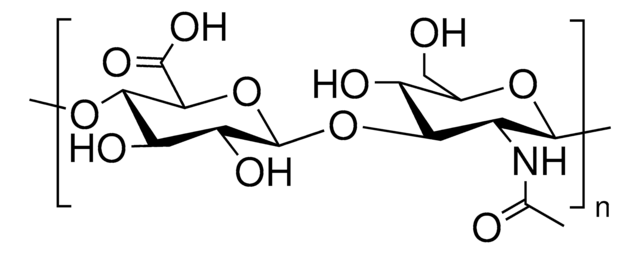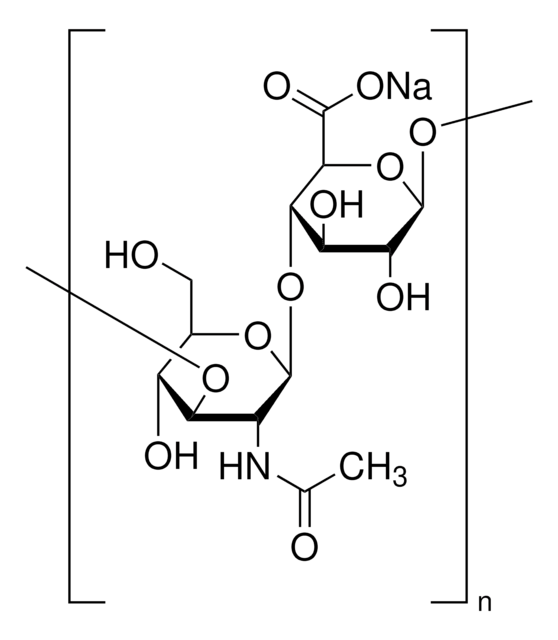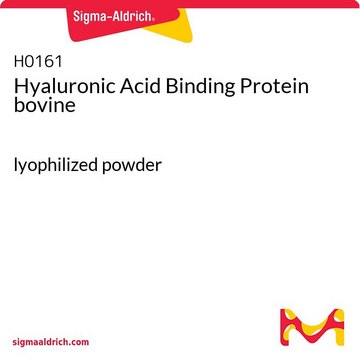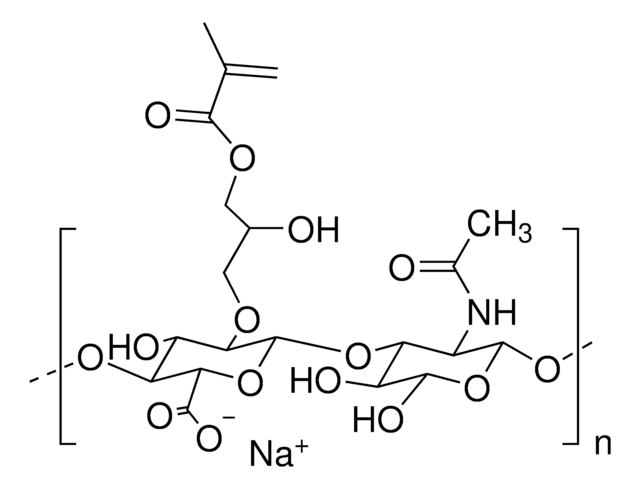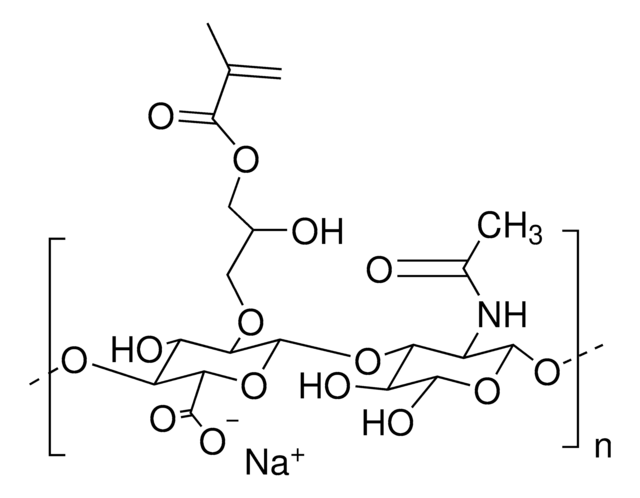924474
Hyaluronic Acid
Low Viscosity, Low endotoxin
Synonim(y):
3D bioprinting, HA, Hyaluronan
Zaloguj sięWyświetlanie cen organizacyjnych i kontraktowych
About This Item
Kod UNSPSC:
12352201
NACRES:
NA.23
Polecane produkty
Poziom jakości
Formularz
(powder or chunk(s) or fibers)
zanieczyszczenia
<10 CFU/g Bioburden
<100 EU/g Endotoxin
kolor
white to off-white
przydatność
conforms to structure for NMR
temp. przechowywania
2-8°C
Powiązane kategorie
Opis ogólny
Hyaluronic acid (HA) is a linear polysaccharide of alternating D-glucuronic acid, and N-acetyl-D-glucosamine found in the extracellular matrix. HA is commonly chemically modified to form covalently crosslinked hydrogels. Other properties of HA include cell surface receptors CD44 and RHAMM recognition and degradation via hyaluronidases.
Zastosowanie
HA is increasingly used for the following biomedical applications:
Our low endotoxin HA is tested for both endotoxin (< 100 EU/g) and bioburden (< 10 CFU/g) levels, so you can choose which material is right for your research.
- Cell migration
- Angiogenesis
- Viability
- Proliferation
Our low endotoxin HA is tested for both endotoxin (< 100 EU/g) and bioburden (< 10 CFU/g) levels, so you can choose which material is right for your research.
Ta strona może zawierać tekst przetłumaczony maszynowo.
Kod klasy składowania
11 - Combustible Solids
Klasa zagrożenia wodnego (WGK)
WGK 3
Temperatura zapłonu (°F)
Not applicable
Temperatura zapłonu (°C)
Not applicable
Wybierz jedną z najnowszych wersji:
Certyfikaty analizy (CoA)
Lot/Batch Number
It looks like we've run into a problem, but you can still download Certificates of Analysis from our Dokumenty section.
Proszę o kontakt, jeśli potrzebna jest pomoc Obsługa Klienta
Masz już ten produkt?
Dokumenty związane z niedawno zakupionymi produktami zostały zamieszczone w Bibliotece dokumentów.
Tracey J Brown
Current pharmaceutical biotechnology, 9(4), 253-260 (2008-08-12)
Despite advances in chemotherapeutic regimens, the treatment of metastatic cancer remains a challenge. A key problem with chemotherapy drugs is nonspecific drug distribution, resulting in low tumor concentrations and systemic toxicity. The holy grail of clinical cancer research has been
Federica Camin et al.
Journal of agricultural and food chemistry, 58(1), 570-577 (2009-12-17)
H, C, and O stable isotope ratios and the elemental profile of 267 olive oils and 314 surface waters collected from 8 European sites are presented and discussed. The aim of the study was to investigate if olive oils produced
Xian Xu et al.
Soft matter, 8(12), 3280-3294 (2012-03-16)
Hyaluronic acid (HA) is one of nature's most versatile and fascinating macromolecules. Being an essential component of the natural extracellular matrix (ECM), HA plays an important role in a variety of biological processes. Inherently biocompatible, biodegradable and non-immunogenic, HA is
Kevin T Dicker et al.
Acta biomaterialia, 10(4), 1558-1570 (2013-12-24)
Hyaluronan (HA) is a linear polysaccharide with disaccharide repeats of d-glucuronic acid and N-acetyl-d-glucosamine. It is evolutionarily conserved and abundantly expressed in the extracellular matrix (ECM), on the cell surface and even inside cells. Being a simple polysaccharide, HA exhibits
Global Trade Item Number
| SKU | GTIN |
|---|---|
| 924474-500MG | 4065267321943 |
Nasz zespół naukowców ma doświadczenie we wszystkich obszarach badań, w tym w naukach przyrodniczych, materiałoznawstwie, syntezie chemicznej, chromatografii, analityce i wielu innych dziedzinach.
Skontaktuj się z zespołem ds. pomocy technicznej